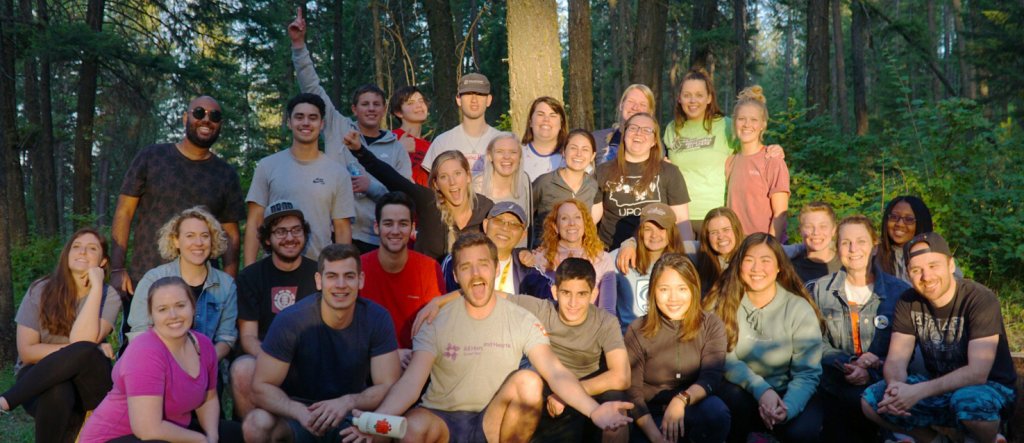Stutter with confidence. That is the philosophy at the heart of the Successful Stuttering Management Program (SSMP), a treatment program developed at Eastern Washington University and used for more than 35 years by faculty and students in EWU’s Communication Sciences and Disorders Program.
Last week, EWU graduate students served as clinicians for seven stutterers, teaching them how to deal “honestly” with their stuttering disorder, gaining control and confidence in their daily interactions with others.
Confidence is the key, because, as SSMP Director Emily Erwin explains, there is no cure for stuttering. “Our program starts with that premise––that you will always stutter.”
“There are a lot of programs that want to fix it and say their graduates are going to graduate with what we call fluent speech and not stutter anymore,” says Erwin. “They’ll get there by the end of the program with some of these other programs, but it doesn’t last. They can’t stay fluent. They are wired to stutter, and so they’ll always stutter.”
The SSMP is the creation of Dorvan Breitenfeldt, PhD, himself a stutterer. He developed the program to train professional speech-language pathologists after his own failed therapy experiences. Breitenfeldt noted that his therapists were all trying to fix his speech, not his sometimes-debilitating fear of stuttering. Using that insight, he went on to create a program designed to treat the stutterer, not the stuttering.
Eastern’s SSMP pairs paying clients with Eastern students, who serve as clinicians. This year, all of the clinicians were graduate students, though in past years undergraduates have participated as well. The program will accept a maximum of eight clients. This year there were seven, ranging from age 12 to 57.
Alissa McPherson, a second-year grad student from Portland, was one of the communication sciences and disorders graduate students involved this year.
“As life changing as it is for the people who stutter, I think the clinicians have gotten just a remarkable experience out of this,” she says.
McPherson and the other clinicians worked one-on-one with the stutterers. A typical morning involved individual therapy sessions, technique lessons and practice sessions. Afternoons were spent out in the community talking to real people. That’s the scary part for people who stutter, but confronting their fears is crucial to learning to stutter with confidence.
“People who stutter become afraid that they will stutter,” explains Erwin. “They fear they will stutter when ordering food in restaurants, they fear they will stutter talking on the phone.”
“It’s mostly going up to people and asking for directions or performing stuttering surveys––so they have to read a script asking pretty simple questions about stuttering,” says McPherson. “They’re using their techniques while they’re doing it so they can get more practice.”

This field experience has a huge impact on the clients. They learn a tremendous amount in a short period of time.
“Normally it takes me a long time to just say my name. But to you I can do it very good now,” says 57-year-old client Tung Tran.
While the program is typically geared toward pre-teens and teens, Tran was welcomed. He traveled from Seattle to take part after reading about the success of this type of program. By day six he was able to talk to a reporter with confidence and a smile.
“I can look more at the people while talking,” he says. “Normally people who stutter are shy. When we talk, we keep looking down.”
“Eye contact is one of the first things we work on because it lets you know as a listener that I’m stuttering and I’m not afraid to tell you, that I’m confident in it, and you can just look at me.” explains McPherson.
The youngest client in this year’s program says he picked up on that quickly.
“My confidence has grown,” says 12-year-old Landon Lacaria of Coeur d’Alene. “And my eye contact has gotten a lot better. I’ve learned new techniques to help me with my stuttering and help me manage it better.”
Not all of the confidence building field trips involve public speaking. One that stood out to many of the clients involved physical challenges.
“We went to this ropes course called Adventure Dynamics, and we did team building activities there,” says Lacaria. “It was fun.”
“You’re really challenged to do very physical and scary things. Like going on a zipline, and climbing a ropes course, or going on this huge rope swing––just a lot of really challenging things that are a great analogy for putting yourself out there and getting used to it, not fearing it,” says McPherson.

A week full of challenging and emotional experiences lead to some powerful moments between the clinicians and their clients. Most clients experience a change in perspective.
“Landon said he was proud to be part of the 20 percent of people who persist in stuttering,” says McPherson. “He said that in front of the whole group. There wasn’t a dry eye in the house. It was so sweet.”
The clients leave with a toolkit of new techniques to help them manage their stutter with confidence, techniques that require daily work from the stutters. They’re also encouraged to return for a program refresher.
At the end of this year’s program, the optimism and appreciation from the stutterers was clear.
“They helped me with my stutter, but they also helped me with just having fun at this camp,” says Lacaria.
“The program, the supervisors and the clinicians, they’re very dedicated to the patient,” adds Tran.
If you would like to learn more about the Successful Stuttering Management Program (SSMP), please go to their website. To explore additional programs in the College of Health Science and Public Health at EWU, click here.

